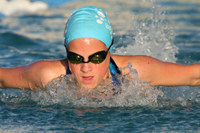 More than 42,000 male and female swimmers have competed at Division 1 universities in the past 25 years, however, little information exists on injury patterns for these athletes. In a new study, published in the October issue of the American Journal of Sports Medicine, researchers at the University of Iowa collected data from a five-year period to determine injury patterns and prevention strategies.
More than 42,000 male and female swimmers have competed at Division 1 universities in the past 25 years, however, little information exists on injury patterns for these athletes. In a new study, published in the October issue of the American Journal of Sports Medicine, researchers at the University of Iowa collected data from a five-year period to determine injury patterns and prevention strategies.
"Thirty-seven percent of the injuries suffered by the swimmers in our study resulted in missed time. By analyzing these injury patterns, we hope training programs can be modified to protect and strengthen those body areas that were most often injured, such as the shoulder," says Brian Wolf, MD, lead author and assistant professor of orthopaedics at the University of Iowa Hospitals and Clinics.
Researchers investigated the overall injury rates from 44 male and 50 female collegiate swimmers from 2002-2007. The overall injury rates were estimated to be 4.00 injuries per 1,000 exposures for men and 3.78 injuries per 1,000 exposures for women.
The shoulder/upper arm was the most commonly injured body part (likely the result of the repetitive strain on the shoulders during swimming), followed by
the neck and back. Swimmers who specialized in strokes other than freestyle were at 33% greater risk of injury than swimmers who were primarily freestyle specialists. Nearly 4 out of 10 (38%) of injuries in the study resulted from team activities out of the pool, including strength training and dry-land workouts.
Freshmen swimmers at greatest injury risk
The "most remarkable" finding of the study was that freshmen swimmers suffered the highest total number of injuries as well as the highest average number of injuries per swimmer, with the number of injuries and injury rates declining after the freshman season, with a gradual decline for men and a more dramatic decline for women, and a significant decrease in injury risk in later years of eligibility.
The study speculated that the high prevalence of overuse-type injuries during the early college years was likely explained by the transition from high school and club swimming training regimens to the substantially more intense training - both in terms of increased yardage and additional cross-training activities - at the college level, with a decline in injuries as swimmers became accustomed to the yardage and workout routine.
"Our research highlights the importance of properly preparing and transitioning freshmen athletes into collegiate swimming through strength training and gradual increases in distance. This is especially true for those athletes unaccustomed to collegiate level yardage requirements in practice and for those who have not previously done strength and cross training activities outside of the pool," says Wolf.
Injury prevention
The finding that nearly 40% of injuries occured out of the pool suggested that close scrutiny of cross-training programs, and possible alteration of out-of-pool training activities, was warranted.
The high incidence of shoulder injuries, said the study's authors, made it reasonable to consider the advisability of preventive training programs focused on shoulder injuries.
Wolf and his colleagues hope that with increased research, injury surveillance and improved training techniques swimming injuries will be better understood and prevented.
Source: The American Orthopaedic Society for Sports Medicine (AOSSM); Wolf, Brian R., et al. "Injury Patterns in Division I Collegiate Swimming." Am. J. Sports Med. 2009; 37 , No. 10; 2037-2042.
Created: September 30, 2009








